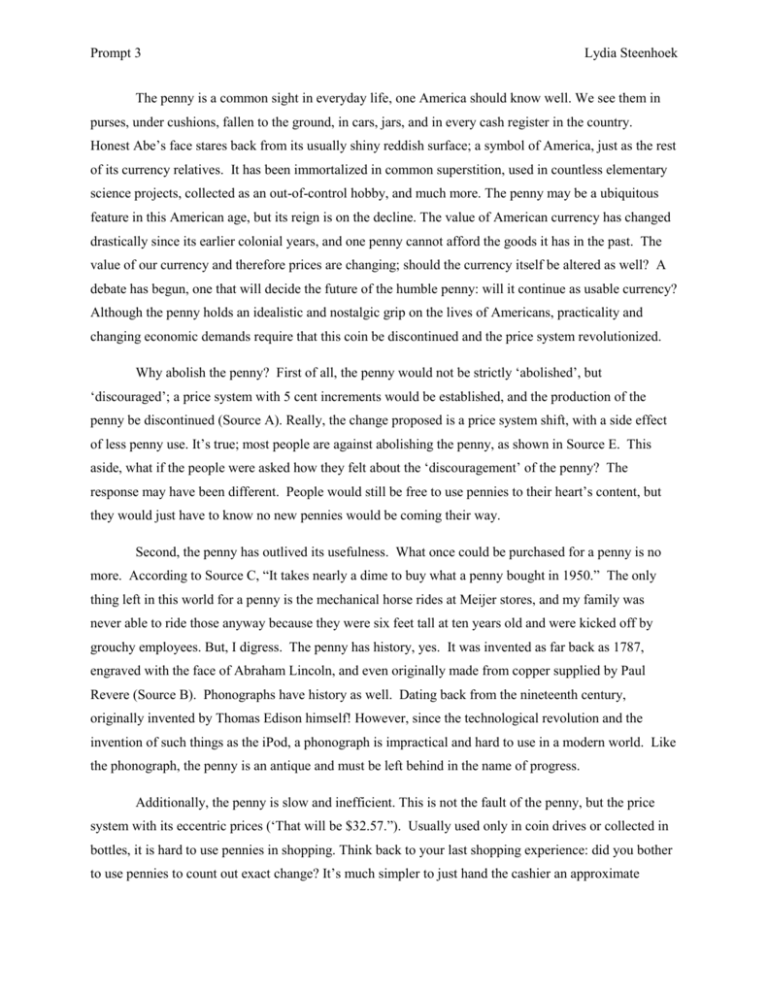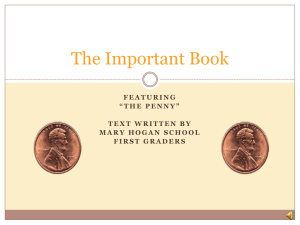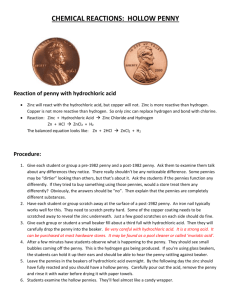Synthesis 2 - WordPress.com
advertisement

Prompt 3 Lydia Steenhoek The penny is a common sight in everyday life, one America should know well. We see them in purses, under cushions, fallen to the ground, in cars, jars, and in every cash register in the country. Honest Abe’s face stares back from its usually shiny reddish surface; a symbol of America, just as the rest of its currency relatives. It has been immortalized in common superstition, used in countless elementary science projects, collected as an out-of-control hobby, and much more. The penny may be a ubiquitous feature in this American age, but its reign is on the decline. The value of American currency has changed drastically since its earlier colonial years, and one penny cannot afford the goods it has in the past. The value of our currency and therefore prices are changing; should the currency itself be altered as well? A debate has begun, one that will decide the future of the humble penny: will it continue as usable currency? Although the penny holds an idealistic and nostalgic grip on the lives of Americans, practicality and changing economic demands require that this coin be discontinued and the price system revolutionized. Why abolish the penny? First of all, the penny would not be strictly ‘abolished’, but ‘discouraged’; a price system with 5 cent increments would be established, and the production of the penny be discontinued (Source A). Really, the change proposed is a price system shift, with a side effect of less penny use. It’s true; most people are against abolishing the penny, as shown in Source E. This aside, what if the people were asked how they felt about the ‘discouragement’ of the penny? The response may have been different. People would still be free to use pennies to their heart’s content, but they would just have to know no new pennies would be coming their way. Second, the penny has outlived its usefulness. What once could be purchased for a penny is no more. According to Source C, “It takes nearly a dime to buy what a penny bought in 1950.” The only thing left in this world for a penny is the mechanical horse rides at Meijer stores, and my family was never able to ride those anyway because they were six feet tall at ten years old and were kicked off by grouchy employees. But, I digress. The penny has history, yes. It was invented as far back as 1787, engraved with the face of Abraham Lincoln, and even originally made from copper supplied by Paul Revere (Source B). Phonographs have history as well. Dating back from the nineteenth century, originally invented by Thomas Edison himself! However, since the technological revolution and the invention of such things as the iPod, a phonograph is impractical and hard to use in a modern world. Like the phonograph, the penny is an antique and must be left behind in the name of progress. Additionally, the penny is slow and inefficient. This is not the fault of the penny, but the price system with its eccentric prices (‘That will be $32.57.”). Usually used only in coin drives or collected in bottles, it is hard to use pennies in shopping. Think back to your last shopping experience: did you bother to use pennies to count out exact change? It’s much simpler to just hand the cashier an approximate Prompt 3 Lydia Steenhoek amount of money and let them do the work of counting out the pennies. Jeff Gore, an MIT graduate with too much time to spare, calculated that handling pennies adds over 2 seconds per transaction, which approximates to 4 hours a year per person struggling with pennies (Source B). Counting pennies is a lot of work for both sides of the transaction; by rounding off the price to the nearest 5 cents, purchasing becomes more efficient and simpler. Many people want to hold on to the precious penny, because it is a ‘symbol of America.’ They are right, but a penny can make a perfectly wonderful symbol in a museum just as well as an annoying and useless coin in circulation. The penny is not a harmful or horrible thing, but it is time to move forward. Some argue that the penny is important to our pricing system, and that ‘all major industrialized countries’ have a one-cent increment (Source D), why can’t we? Well, the reason the penny is used nowadays is our price system; if the price system were to change, penny usefulness would disappear. Repeat, the penny is not the real problem; it’s the pricing system. Although ‘all major industrialized countries’ may have a sort of penny, that does not mean we have to follow the crowd. America can lead a pricing revolution by adopting a more efficient system. Perhaps those countries will even follow our lead. The penny may be popular, and it may be symbolic, but it is fueled by the inefficiency of our price system and vice versa. The penny has had its day, but it is time to retire: it has become basically useless and painfully slow in a culture of super speed. By rounding the price system into five cent increments, America can both improve the pricing system and gently lay to rest one of its most infamous coins. The penny has enjoyed a long and full life; let us remember its glory days, but be able to move full steam ahead for a greater economic future!





